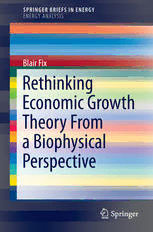
Rethinking Economic Growth Theory From a Biophysical Perspective PDF
Preview Rethinking Economic Growth Theory From a Biophysical Perspective
SpringerBriefs in Energy Energy Analysis SeriesEditor CharlesA.S.Hall Forfurthervolumes: http://www.springer.com/series/8903 Blair Fix Rethinking Economic Growth Theory From a Biophysical Perspective 2123 BlairFix FacultyofEnvironmentalStudies YorkUniversity Toronto Ontario Canada ISSN2191-5520 ISSN2191-5539(electronic) SpringerBriefsinEnergy ISBN978-3-319-12825-2 ISBN978-3-319-12826-9(eBook) DOI10.1007/978-3-319-12826-9 LibraryofCongressControlNumber:2014954806 SpringerChamHeidelbergNewYorkDordrechtLondon © TheAuthor(s)2015 Thisworkissubjecttocopyright.AllrightsarereservedbythePublisher,whetherthewholeorpartofthe materialisconcerned,specificallytherightsoftranslation,reprinting,reuseofillustrations,recitation, broadcasting,reproductiononmicrofilmsorinanyotherphysicalway,andtransmissionorinformation storageandretrieval,electronicadaptation,computersoftware,orbysimilarordissimilarmethodology nowknownorhereafterdeveloped. Theuseofgeneraldescriptivenames,registerednames,trademarks,servicemarks,etc.inthispublication doesnotimply,evenintheabsenceofaspecificstatement,thatsuchnamesareexemptfromtherelevant protectivelawsandregulationsandthereforefreeforgeneraluse. Thepublisher,theauthorsandtheeditorsaresafetoassumethattheadviceandinformationinthisbook arebelievedtobetrueandaccurateatthedateofpublication.Neitherthepublishernortheauthorsorthe editorsgiveawarranty,expressorimplied,withrespecttothematerialcontainedhereinorforanyerrors oromissionsthatmayhavebeenmade. Printedonacid-freepaper SpringerispartofSpringerScience+BusinessMedia(www.springer.com) ToEmily,forherloveandsupport,andGarry andGrace,fortheirproof-readingprowess. Acknowledgements I would like to thank Charles Hall and Kent Klitgaard for their many helpful sug- gestionsduringtheeditingphaseofthisbook,andforemphasizingtheimportance ofabiophysicalapproachtoeconomics.IwouldalsoliketothankJonathanNitzan, who encouraged me to abandon the use of real GDP. The unorthodox empirical methodologydevelopedinthisbookwouldnothaveoccurredwithoutJonathan’sin- fluence.IalsooweagreatdebttoRobertAyresandBenjaminWarraswellasMario Giampietro,KozoMayumi,andAlevgulSorman.Theinnovativeworkofthesebio- physicalscholarshasdeeplyinfluencedmyownapproach.Thank-youalsotoEllie Perkins,MarkThomas,andPeterVictor,whoprovidedmanyhelpfulcommentson myMaster’sThesis,whichwastheinitialseedforthisbook. vii Acronyms Abbreviations A TechnologicalProgress(Solow-Residual) AG Agriculture α Capital’sincomeshare β Labor’sincomeshare D TotalDebt FF FossilFuel E Energy EROI EnergyReturnonInvestment GDP GrossDomesticProduct IN Industry J Joule K Capital KWH Kilowatt-Hour L Labor M MiningSectororMoneySupply n Nominal S Services SPP SpecificPurchasingPower P Unit-PriceorPopulationpcPerCapita V VelocityofMoney Q Quantity R NaturalResources r Real ρ Productivity U UsefulWork Y QuantityofFinalProduction(unspecifiedunit) Yn NominalGDP Yr RealGDP DataSources BEA BureauofEconomicAnalysis BLS BureauofLaborStatistics EIA EnergyInformationAdministration HSUS HistoricalStatisticsoftheUnitedStates ix Contents 1 Introduction................................................... 1 1.1 ABiophysicalPerspective ................................... 1 1.2 NeoclassicalGrowthTheory ................................. 3 1.3 MethodologicalApproach:RelationtoExistingTheory........... 5 1.3.1 TheBiophysicalCritique.............................. 6 1.3.2 TheFunctionalFormCritique.......................... 7 1.3.3 TheMeasurementCritique ............................ 9 1.3.4 AnUnorthodoxApproach ............................. 11 1.4 GoalsandBookLayout ..................................... 13 References ..................................................... 14 2 Decoupling .................................................... 17 2.1 NaturalResourcesinNeoclassicalGrowthTheory ............... 18 2.2 MeasuringDecoupling ...................................... 19 2.3 ProblemswithRealGDP .................................... 22 2.4 Decoupling:FactorArtifact?................................. 29 2.5 DecouplinginTheoryandReality:WhatGoesWrong............ 38 2.6 Conclusions:MonetaryValueasaFeedback .................... 40 References ..................................................... 42 3 Distribution ................................................... 45 3.1 MeasuringGrowth.......................................... 46 3.2 FunctionalDistribution...................................... 48 3.3 Debtor/CreditorDistribution ................................. 51 3.4 PersonalDistribution........................................ 56 3.5 Conclusions:DistributionMatters............................. 59 References ..................................................... 60 4 InstitutionalSize ............................................... 63 4.1 InstitutionsinNeoclassicalGrowthTheory ..................... 63 4.2 TheoriesofLargeInstitutions ................................ 67 4.2.1 TheoriesoftheFirm.................................. 67 xi xii Contents 4.2.2 TheoriesofGovernmentSize .......................... 69 4.3 InstitutionalSizeandtheGrowthofEnergyConsumption:Empirical Evidence ................................................. 72 4.4 TheImportanceofHierarchy................................. 75 4.5 Conclusions:SizeMatters ................................... 81 References ..................................................... 82 5 LaborStructure ............................................... 85 5.1 LaborinNeoclassicalGrowthTheory.......................... 86 5.2 TheoriesofLaborStructureChange ........................... 87 5.3 ThreeHypotheses .......................................... 90 5.4 ModellingChangesinLaborStructure......................... 94 5.5 LaborStructureandEnergy:EmpiricalEvidence ................ 101 5.6 Conclusions:LaborStructureMatters.......................... 105 References ..................................................... 106 6 TowardaBiophysicalGrowthTheory ............................ 109 6.1 TheProblemwithNeoclassicalGrowthTheory.................. 109 6.2 ABiophysicalApproach..................................... 111 6.3 StylizedBiophysicalFacts ................................... 113 6.4 Conclusions ............................................... 114 References ..................................................... 116 AppendixUSSectors:MethodologyandSources...................... 119 Index ............................................................ 123 Chapter 1 Introduction Alltheorydependsonassumptionswhicharenotquitetrue. Thatiswhatmakesittheory. –RobertSolow(1956,p.65) 1.1 ABiophysicalPerspective Thepurposeofthisbookistobeginthinkingaboutwhatabiophysicalgrowththeory mightlooklike.Alltheoriesmuststartbyexcludingfromtheirscopethecomplexities oftherealworldthataredeemedirrelevant.Suchexclusion(orreductionism)makes scientificinquirypossible.Forinstance,priortoIsaacNewton,itwasassumedthat objects in motion tended to eventually come to a rest. However, by excluding the forcesoffrictionfromanalysis,Newtonwasabletoshowthattheoppositewastrue: objectsinmotiontendedtostayinmotionunlessacteduponbyanexternalforce. Yet excluding real-world complexities is a tricky business. If a theory excludes fromitsscope,theveryforcesthatarecausingthebehaviorinquestion,wehavea problem.Inthiscase,over-judicioussimplificationbecomesacrutch:itmakesmath- ematicalformalizationpossible,butyieldsamodelthathaslittletodowithreality. Onlythroughrigorousempiricalinvestigation(andnotthroughlogicaldeduction), canonedistinguishbetweengoodandbadassumptions. Thus, the most appropriate starting point for a biophysical growth theory is to investigatethevalidityofassumptionsmadebyexistinggrowththeories.Sinceneo- classical growth theory is the dominant approach at the present time, this book empirically investigates neoclassical assumptions. The goal of this endeavor is to decide upon the essential elements of the growth process and to compile a set of stylizedfactsthatabiophysicalgrowththeorymustsuccessfullyexplain. Not surprisingly, most existing growth theories are interested in explaining the phenomenonofsustainedexponentialgrowth. However, whileexponentialgrowth seems“normal”tothemodernobserver,itisahistoricalanomaly.Thevastmajorityof humanhistoryhasbeencharacterizedbystableequilibrium,notexponentialgrowth. Figure1.1showstwoscenariosforthefuture.Economiststypicallyassumeafuture like Scenario A, with an indefinite continuation of exponential growth. Geologist M. King Hubbert, on the other hand, envisions a future like Scenario B, in which exponentialgrowthisa“transientphenomenoninhumanhistory”(1993). ©TheAuthor(s)2015 1 B.Fix,RethinkingEconomicGrowthTheoryFromaBiophysicalPerspective, SpringerBriefsinEnergy,DOI10.1007/978-3-319-12826-9_1
